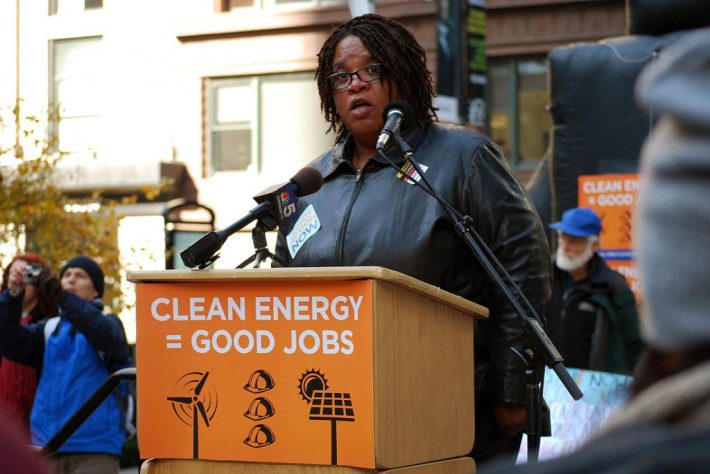Earlier this afternoon the Chicago City Council passed the transit tax-increment financing district for the south Red Line extension, making it very likely that Far South Siders will finally get the rapid transit service they've been waiting for for 50-plus years.
Back in 1968, then-mayor Richard J. Daley announced that the 'L' system would be extended south to near the city limits, but that promise was never fulfilled. However, in recent years the CTA has been working on a plan for the 5.6-mile extension from the 95th-Dan Ryan Red Line terminal in Roseland to 130th Street in the Altgeld Gardens housing project in the Riverdale community area, serving predominantly lower-income African-American neighborhoods. The project is projected to cut a one-way transit trip from 130th to the Loop by 30 minutes. The route runs through four community areas, also including Washington Heights and West Pullman, with a total population of about 100,000.
The transit TIF (which, unlike a regular TIF, doesn't divert property tax revenue from public schools) is projected raise an estimated $959 million to help pay for the $3.6 billion ‘L’ extension. Most of the remaining money would come from federal grants, which U.S. Department of Transportation secretary Pete Buttigieg has indicated the feds will provide.
A similar strategy was used to pay for the $2.1 billion Red and Purple Modernization project on the North Side. However, the Red Line extension TIF has faced more opposition because, unlike the RPM funding mechanism, the property tax revenue that would be collected from the new TIF districts wouldn't be reinvested in the same areas. Instead the RLE TIF would capture revenue from relatively prosperous downtown and Near South Side neighborhoods, and redistribute it to the struggling Far South Side.

Some residents and politicians from the areas that would be TIFed, most notably Near South alder Pat Dowell (3rd), have argued that's unfair. At last Monday's Finance Committee hearing on the measure, Dowell was the sole no vote. She quoted a constituent: "When you take TIF money from one neighborhood and spend it in another, it really feels like theft. It feels lowdown and dirty."
The problem with that logic is that is that it's not as if the property tax money from the new TIF districts would otherwise be earmarked for those areas. Instead, that money would simply go into Chicago's general coffers, and it could be spent anywhere in the city.
Meanwhile, Far South Siders and other supporters have noted that the extension would have a significant racial equity impact by connecting low-income residents with jobs, education, and healthcare, and spurring new housing and retail development in underserved communities. "This will be one of the single largest investments on the Far South Side in more than half a century and its impact cannot be overstated," said Abraham Lacy, president of the Far South Community Development Corporation, in a statement released this morning.

Lacy noted that the future stations will be located near Morgan Park Commons, an upcoming 286-unit mixed-use housing development at 115th and Halsted, and the Roseland Community Medical District. "The Red Line Extension is not just a transportation improvement—it ties into significant ongoing equitable development work in this region that Far South CDC and other groups have been advocating for and championing for decades."
Interestingly, Dowell was silent during today's City Council discussion of the proposed transit TIF, but several other alderpersons voiced support. "Our community has been disinvested, disenfranchised, and disconnected from this city for a very long time," said Far South Side alder Anthony Beale (9th), who grew up in the area. "And so now [we're well along] in the federal process to get to construction... I'm just hoping that I'm around long enough to see it."
"We need more investments in public transportation," noted Northwest Side Gilbert Villegas (36th.) "Because if we're going to be a world-class city, we've got to make sure that all communities [have good transit access.] When you look at other countries, when it comes to public transportation, we're way behind."

West Side alder Jason Ervin (28th) argued that better transit access for the Far South Side would benefit all Chicagoans in the long run. "A rising tide lifts all boats." He noted that the extension will help connect local residents with jobs that need to be filled on the other side of town. "One person said, 'It [currently] takes us two hours to take a bus, to another bus, to a train, to a bus, just to go to school.' That should not be." He called on other alders to support bringing the 'L' to a "transit-starved" part of town.
"This is about fairness and equity," noted Finance Committee chair and North Side alder Scott Waguespack (32nd.) He read a statement from Altgeld Gardens resident Cheryl Johnson, whose mother Hazel was a local environmental justice activist: "If the city moves on the Red Line extension, what a great benefit it will be for this area. We could go from the Riverdale community area all the way to Loyola [University], to Howard [Avenue], to Rogers Park. One [seat], straight, how convenient would that be?" She noted that would bring access to new opportunities to an area that badly needs them.

The various measures associated with the TIF were then passed in a roll call vote, with Dowell once again being the only dissenter. Mayor Lori Lightfoot, who helped push the transit TIF through the Council, then said. "Congratulations to the Far South Side," and the Council chamber was filled with applause.
Indeed, now that the Red Line extension is probably going to happen, it appears that the dream of 'L' service in this long-neglected part of town will no longer be deferred.





